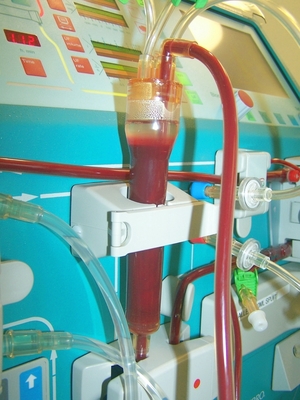Kidney dialysis works by filtering waste and excess water from the blood or body. Kidney dialysis can be performed two ways: hemodialysis and peritoneal dialysis. According to the FDA, approximately 217,000 people in the United States use kidney dialysis to help them live normal lives when their kidney function is failing or has failed.
Hemodialysis filters waste and excess water from the blood by using a man-made membrane (the dialyzer). This procedure is done in a medical center on an outpatient basis, three times per week.
Hemodialysis is performed on a patient by inserting two separate needles into a port that has been surgically attached to a patient. Sites for the port are usually at the wrist, chest or neck. One needle removes the blood and the other needle returns the cleaned blood to the patient’s arm. The dialysis machine looks a little like a bank ATM machine with two hoses leading to the needles in the patient’s wrist. The machine cleans the blood before it is returned to the patient’s body. The procedure lasts approximately three hours. Many patients read, watch television or simply nap during the procedure. Approximately 90 percent of those with kidney failure use hemodialysis.
Peritoneal dialysis uses the lining of the abdomen (peritoneal membrane) and a salt solution (dialysate) to filter waste and excess fluid from the body. This procedure can be done several times a day or overnight in a patient’s own home. Patients who want independence from the schedule of hemodialysis may opt for this form of dialysis.
A patient using peritoneal dialysis has a peritoneal catheter surgically implanted in their belly. There are two ways to perform the peritoneal dialysis: continuous cycling peritoneal dialysis (CCPD) or continuous ambulatory peritoneal dialysis (CAPD). During the CAPD procedure, a patient pours approximately two quarts of dialysate solution into the catheter. The patient then drains the dialysate after three or four hours and then repeats the procedure. Draining the fluid takes approximately one half-hour and it is a painless procedure.
The CCPD procedure is usually performed overnight, making it a good option for children needing kidney dialysis. A machine warms and monitors the dialysate for ten hours. This frees the person using this form of dialysis during the day so that they can do other things, such as attend school or work a full time job.
The mortality rate for people using dialysis in the United State is 23 percent. The average person on dialysis uses it temporarily until an infection of the kidneys clears or they are able to have a kidney transplant. People are able to use kidney dialysis for the long term but their mortality rate increases each year that they continue using it.
People that undergo kidney dialysis can live a normal life as long as no infection occurs. Patients that use the peritoneal dialysis occasionally can get an infection in their peritoneal lining. When this occurs the patient has the option of waiting for the infection to clear or switching to hemodialysis. Whether the patient chooses hemodialysis or peritoneal dialysis, the end result is the same: the waste products can be effectively removed from their blood or body fluid by using dialysis.


